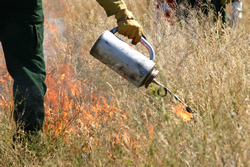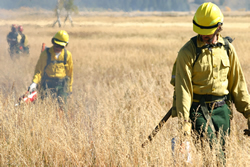
National Fire Plan Success Story
Resource and Fire Managers Join Forces to Restore Native Rangeland
Grand Teton National Park, Wyoming
National Fire Plan - Rehabilitation
2008

A firefighter lights unwanted non-native vegetation as part of a two-part approach to restore hayfields to native vegetation

Firefighters burn an area of the old Hunter Ranch hayfield on Grand Teton National Park. Resource managers will follow the burn with herbicides in an effort to restore native vegetation.
Grand Teton National Park fire and resource managers took steps in fall 2008 to implement a 4,000-acre native rangeland restoration project when they burned the 271-acre Aspen Ridge/Hunter hayfield. The Hunter Ranch prescribed fire project was developed in conjunction with a multistage restoration project of converting pasture land back to native vegetation. The project is part of a joint NPS/USFWS management plan for bison and elk in the National Elk Refuge and Grand Teton National Park.
The prescribed fire project area was an irrigated hayfield prior to the 1970s. Despite decades-long recovery time, the hayfield is still dominated by non-native agronomic grasses and noxious weed species.
“Non-native, perennial grasses are a serious impediment to native plant succession and restoration,” said ecologist Kelly McCloskey. “Without intervention and management, the pasture grasses, particularly smooth brome, will likely remain, preventing natural succession. Prescribed fire appears to be useful as an adjunct to the herbicide treatment and, especially, as a seed-bed preparation tool.”
Prior to the burn, resource managers treated 100 acres of the site area with herbicide to remove the non-native species. They applied herbicide to the remaining 100 acres post burn to help re-establish native species.
"This entry is the first large-scale treatment in what is expected to be a multi-year effort,” said Chip Collins, assistant fire management officer. “Dependent upon results measured in succeeding years, additional herbicide / prescribed fire combination treatments will occur across the historic hayfields in the Mormon Row/Ditch Creek area of the park. Treatment units will be developed collectively by resource and fire managers to ensure appropriate scale and layout are considered to meet objectives."
Contact: Chip Collins, Assistant Fire Management Officer, (307) 739-3312.